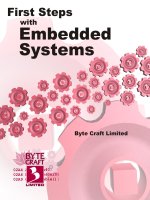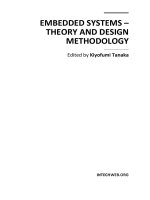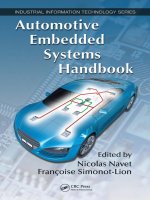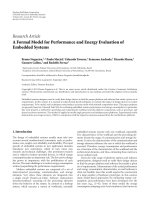First step with embedded systems
Bạn đang xem bản rút gọn của tài liệu. Xem và tải ngay bản đầy đủ của tài liệu tại đây (2.54 MB, 228 trang )
First Steps
Embedded
Systems
with
ox40;
gs&0x20)
table();
02A4 A
02A6 B
02A9 C
Byte Craft Limited
421 King Street North
Waterloo, Ontario
Canada
N2J 4E4
Tel: 519-888-6911
Fax: 519-746-6751
Do Byte Craft Limited compilers
support ANSI C?
All Byte Craft compilers are ANSI compatible within the
limitations of the target hardware.
How efficient is the optimizer
compared to hand-written
assembler code?
The compiler generates object code as tight and
efficient as most hand-written assembler code.
Can I combine C code and
assembler in my programs?
You can embed assembler code within your C program,
using #asm and #endasm preprocessor directives. The
embedded code can call C functions and directly
access C variables. To pass arguments conveniently,
embed your assembly code in the body of a C function.
What kinds of emulator hardware
do the compilers support?
For more information on supported emulator products,
contact Byte Craft Limited support staff.
How do the compilers handle local
variable declarations?
Our compilers store locally-declared variables in
reusable local memory spaces. The scope of local
variables is protected.
What are Byte Craft Limited's
terms?
For Canada and the U.S.: For company purchases (on
approved credit), NET 30 days after shipping. Byte
Craft ships next day FedEx free of charge. All other
orders must be prepaid, with American Express, VISA,
check with order, or direct wire transfer.
For overseas: All orders, prepaid with American
Express, VISA, check with order, or direct wire transfer.
Shipping is extra. Please call for more information.
Please obtain appropriate import documentation.
If for any reason you are unsatisfied with your
purchase, you can return it within 30 days for a full
refund.
CDS
Code Development Systems
The Byte Craft Limited Code Development
Systems are high-performance embedded
development packages designed for serious
developers. They generate small, fast, and
efficient code. They enable the professional
developer to produce stand-alone single-chip
microcontroller applications quickly. Developers
can easily port C language applications written
for other embedded platforms to the CDS.
Features
!
The Code Development Systems support
entire families of microcontrollers.
!
The optimizing C language cross-compilers are
ANSI-compatible within hardware limitations.
!
Tight, fast and efficient code optimization
generates clean, customized applications.
!
A built-in Macro Assembler allows inline
assembly language in C source.
!
CDS generate symbol and source reference
information for C source-level debugging with
popular emulators.
!
C language support for interrupt service
routines and direct access to ports.
!
Device files for individual parts precisely
control code generation and resource usage.
!
Complete user documentation comes with
every Code Development System.
!
Absolute Code Mode lets you compile directly
to final code without a separate linking phase.
Alternatively, you can use t
!
Demonstration versions are available from:
/>Versatility
Code Development Systems install under
Windows 95, 98, ME, NT, 2000, or under MS/PC
DOS.
CDS provide symbol table information and a
listing file: a merged listing of C source and
generated assembly language to permit detailed
analysis.
he BClink
Optimizing Linker. Either method performs a
final optimization pass on an entire program.
www.bytecraft.com
First Steps
with Embedded Systems
by
Byte Craft Limited
BYTE CRAFT LIMITED
421 King Street North
Waterloo, Ontario
Canada N2J 4E4
Telephone:
(519) 888-6911
FAX:
(519) 746-6751
Email:
Copyright
!
1997, 2002 Byte Craft Limited. Licensed Material. All rights reserved.
First Steps with Embedded Systems
is protected by copyrights. All rights reserved. No part of this
publication may be reproduced, stored in a retrieval system, or transmitted in any form or by any
means, electronic, mechanical, photocopying, recording, or otherwise without the prior written
permission of Byte Craft Limited.
All example and program code is protected by copyright.
Printed in Canada 14 November, 2002
i
Table of Contents
1. Introduction 1
1.1 Typographical Conventions....................................................................... 1
1.2 Explaining the Microcontroller .................................................................2
1.3 Book Contents ...........................................................................................3
2. Microcontroller Overview 5
2.1 What is a Microcontroller?.........................................................................5
2.2 The Microcontroller in a System............................................................... 7
2.3 Architecture ............................................................................................... 7
2.3.1 Von Neumann ......................................................................................................................8
2.3.2 Von Neumann Memory Map.............................................................................................8
2.3.3 Harvard ..................................................................................................................................9
2.3.4 Harvard Memory Map.......................................................................................................10
2.3.5 The Central Processing Unit ............................................................................................11
2.3.6 Central Processing Unit.....................................................................................................13
2.3.7 ROM.....................................................................................................................................14
2.3.8 RAM .....................................................................................................................................15
2.3.9 I/O Ports.............................................................................................................................16
2.3.10 Timer..................................................................................................................................17
2.3.11 Interrupt Circuitry............................................................................................................18
2.3.12 Buses ..................................................................................................................................19
2.4 Sample Microcontroller Configurations.................................................. 19
2.4.1 Motorola MC68HC705C8 ................................................................................................19
2.4.2 National Semiconductor COP8SAA7 ............................................................................20
2.4.3 Microchip PIC16C54.........................................................................................................20
2.4.4 Microchip PIC16C74.........................................................................................................21
Table of Contents
ii
3. The Embedded Environment 23
3.1 The Embedded Difference ......................................................................23
3.2 Fabrication Techniques ..........................................................................24
3.3 Memory Addressing and Types ..............................................................24
3.3.1 RAM..................................................................................................................................... 24
3.3.2 ROM .................................................................................................................................... 25
3.3.3 PROM ................................................................................................................................. 25
3.3.4 EPROM .............................................................................................................................. 25
3.3.5 EEPROM ........................................................................................................................... 26
3.3.6 Flash Memory..................................................................................................................... 27
3.3.7 Registers .............................................................................................................................. 27
3.3.8 Scratch Pad ......................................................................................................................... 28
3.4 Interrupts .................................................................................................29
3.4.1 Interrupt Handling ............................................................................................................ 30
3.4.2 Synchronous and Asynchronous Interrupt Acknowledgement................................. 30
3.4.3 Servicing Interrupts ........................................................................................................... 31
3.4.4 Interrupt Detection ........................................................................................................... 32
3.4.5 Executing Interrupt Handlers.......................................................................................... 33
3.4.6 Multiple Interrupts ............................................................................................................ 34
3.5 Specific Interrupts ................................................................................... 34
3.5.1 RESET ................................................................................................................................ 35
3.5.2 Software Interrupt/Trap .................................................................................................. 35
3.5.3 IRQ ...................................................................................................................................... 36
3.5.4 TIMER ................................................................................................................................ 36
3.6 Power .......................................................................................................37
3.6.1 Brownout ............................................................................................................................ 37
3.6.2 Halt/Idle ............................................................................................................................. 37
3.7 Input and Output.....................................................................................37
3.7.1 Ports..................................................................................................................................... 37
3.7.2 Serial Input and Output.................................................................................................... 38
3.8 Analog to Digital Conversion ..................................................................40
3.9 Miscellaneous .......................................................................................... 41
3.9.1 Digital Signal Processor .................................................................................................... 41
3.9.2 Clock Monitor .................................................................................................................... 41
Table of Contents
iii
3.10 Devices................................................................................................... 41
3.10.1 Mask ROM........................................................................................................................41
3.10.2 Windowed Parts ...............................................................................................................41
3.10.3 OTP....................................................................................................................................41
4. Programming Fundamentals 43
4.1 What is a Program?.................................................................................. 43
4.2 Number Systems ..................................................................................... 43
4.3 Binary Information.................................................................................. 44
4.4 Memory Addressing ................................................................................ 46
4.5 Machine Language.................................................................................. 46
4.6 Assembly Language ................................................................................ 46
4.6.1 Assembler ............................................................................................................................47
4.7 Instruction Sets........................................................................................ 47
4.8 The Development of Programming Languages ..................................... 48
4.9 Compilers ................................................................................................ 50
4.9.1 The Preprocessor ...............................................................................................................50
4.9.2 The Compiler......................................................................................................................50
4.9.3 The Linker ...........................................................................................................................50
4.10 Cross Development................................................................................ 51
4.10.1 Cross compiler..................................................................................................................51
4.10.2 Cross development tools ................................................................................................51
4.10.3 Embedded Development Cycle.....................................................................................52
5. First Look at a C Program 55
5.1 Program Comments................................................................................. 56
5.2 Preprocessor directives............................................................................ 56
5.3 C Functions ............................................................................................. 58
5.3.1 The main( ) function..........................................................................................................58
5.3.2 Calling a Function ..............................................................................................................59
Table of Contents
iv
5.4 The Function Body..................................................................................60
5.4.1 The Assignment Statement .............................................................................................. 60
5.4.2 Control statements ............................................................................................................ 60
5.4.3 Calling Functions ............................................................................................................... 62
5.5 The Embedded Difference......................................................................62
5.5.1 Device Knowledge ............................................................................................................ 63
5.5.2 Special Data Types and Data Access.............................................................................. 63
5.5.3 Program Flow..................................................................................................................... 63
5.5.4 Combining C and Assembly Language .......................................................................... 63
5.5.5 Mechanical Knowledge..................................................................................................... 64
6. C Program Structure 65
6.1 C Preprocessor Directives........................................................................65
6.2 Identifier Declaration ..............................................................................65
6.2.1 Identifiers in Memory ....................................................................................................... 66
6.2.2 Identifier names ................................................................................................................. 66
6.2.3 Variable Data Identifiers................................................................................................... 67
6.2.4 Constant Data Identifiers ................................................................................................. 67
6.2.5 Function Identifiers........................................................................................................... 68
6.3 Statements ...............................................................................................68
6.3.1 The Semicolon Statement Terminator ........................................................................... 69
6.3.2 Combining Statements in a Block................................................................................... 69
7. Basic Data Types 71
7.1 The ASCII Character Set ......................................................................... 71
7.2 Data types ................................................................................................ 71
7.3 Variable Data Types ................................................................................72
7.3.1 Variable Data Type Memory Allocation........................................................................ 72
7.3.2 Variable Scope.................................................................................................................... 73
7.3.3 Global Scope ...................................................................................................................... 74
7.3.4 Local Scope......................................................................................................................... 74
7.3.5 Declaring Two Variables with the Same Name............................................................ 74
7.3.6 Why Scope is Important................................................................................................... 75
7.4 Function Data Types...............................................................................75
7.4.1 Function Parameter data types ........................................................................................ 76
Table of Contents
v
7.5 The Character Data Type........................................................................ 76
7.5.1 Assigning a character value...............................................................................................76
7.5.2 ASCII Character Arrangement ........................................................................................77
7.5.3 Numeric Characters ...........................................................................................................77
7.5.4 Escape Sequences...............................................................................................................77
7.6 Integer Data Types.................................................................................. 78
7.6.1 Integer Sign Bit...................................................................................................................78
7.6.2 The short Data Type .........................................................................................................78
7.6.3 The long Data type ............................................................................................................79
7.6.4 Different Notations ...........................................................................................................79
7.7 Data Type Modifiers ............................................................................... 79
7.7.1 Signed and Unsigned .........................................................................................................80
7.7.2 Other Data Type Modifiers..............................................................................................80
7.8 Real Numbers ......................................................................................... 80
7.8.1 The float Data Type...........................................................................................................81
7.8.2 The double and long double Types.................................................................................81
7.8.3 Assigning an Integer to a float .........................................................................................81
8. Operators and Expressions 83
8.1 Operators ................................................................................................. 83
8.2 C Expressions.......................................................................................... 84
8.2.1 Binding.................................................................................................................................85
8.2.2 Unary Operators.................................................................................................................85
8.2.3 Binary Operators ................................................................................................................85
8.2.4 Trinary Operator ................................................................................................................86
8.2.5 Operator Precedence .........................................................................................................86
8.2.6 The = Operator..................................................................................................................87
8.3 Arithmetic Operators............................................................................... 88
8.3.1 Increment and Decrement Operators ............................................................................89
8.4 Assignment Operators............................................................................. 90
8.5 Comparison Operators ............................................................................ 91
8.5.1 Expressing True and False................................................................................................91
8.5.2 The Equality Operators.....................................................................................................92
8.5.3 Relational Operators..........................................................................................................92
8.5.4 Logical Operators...............................................................................................................93
Table of Contents
vi
8.6 Bit Level Operators..................................................................................95
8.6.1 Bit Logical Operators........................................................................................................ 95
8.6.2 Bit shift operators.............................................................................................................. 97
9. Control Structures 99
9.1 Conditional Expressions..........................................................................99
9.2 Decision Structures................................................................................ 100
9.2.1 if and else Statements...................................................................................................... 100
9.2.2 Nested if statements........................................................................................................101
9.2.3 Matching else and if.........................................................................................................102
9.2.4 switch and case.................................................................................................................103
9.2.5 Execution within a switch .............................................................................................. 103
9.2.6 Fall-through execution.................................................................................................... 104
9.2.7 The default case ............................................................................................................... 105
9.2.8 The goto Statement ......................................................................................................... 105
9.2.9 Comparing goto and switch..case.................................................................................. 106
9.3 Looping Structures ................................................................................ 106
9.3.1 Control expression ..........................................................................................................106
9.3.2 The while loop.................................................................................................................. 107
9.3.3 The do loop ......................................................................................................................107
9.3.4 The for loop......................................................................................................................108
9.3.5 How the for loop works................................................................................................. 108
9.4 Exiting a Loop....................................................................................... 109
9.4.1 The break Statement ....................................................................................................... 109
9.4.2 The continue Statement.................................................................................................. 109
10. Functions 111
10.1 main() ....................................................................................................111
10.2 Executing a Function ...........................................................................111
10.2.1 Calling a Function..........................................................................................................112
10.3 Function Prototype Declarations..........................................................113
10.3.1 Defining the Function Interface ................................................................................. 113
10.3.2 Calling Functions in Other Files ................................................................................. 113
10.3.3 Function Type, Name and Parameter List ................................................................114
10.3.4 Functions and void........................................................................................................ 115
Table of Contents
vii
10.4 Function Definitions.............................................................................116
10.4.1 Statement Block..............................................................................................................116
10.4.2 Variable Declarations in Function Definitions .........................................................116
10.5 Function Parameters.............................................................................117
10.5.1 Passing Data by Value...................................................................................................117
10.5.2 Passing Data by Reference ...........................................................................................117
10.5.3 Functions Without Parameters ....................................................................................118
11. Complex Data Types 121
11.1 Pointers..................................................................................................121
11.1.1 Declaring a Pointer ........................................................................................................121
11.1.2 Pointer Operators ..........................................................................................................122
11.1.3 Pointer Pitfalls ................................................................................................................123
11.2 Arrays ....................................................................................................124
11.2.1 Accessing Array Elements ............................................................................................124
11.2.2 Multidimensional Arrays...............................................................................................125
11.2.3 Array Operations and Pointer Arithmetic .................................................................125
11.2.4 Arrays of Pointers ..........................................................................................................126
11.3 User Defined Data Types .....................................................................127
11.3.1 Using typedef to Define New Data Types.................................................................127
11.3.2 Using types defined with typedef ................................................................................128
11.4 Enumerated Types................................................................................128
11.4.1 Enumerated Type Elements.........................................................................................129
11.4.2 Enumerated Type Value Checks .................................................................................129
11.4.3 Specifying Values for Enumerated Elements............................................................130
11.5 Structures ..............................................................................................131
11.5.1 The structure tag ............................................................................................................131
11.5.2 Using typedef to Define a Structure ...........................................................................132
11.5.3 Accessing Structure Members......................................................................................132
11.5.4 Indicating a Field with the Dot Operator ..................................................................132
11.5.5 Indicating a Field with the Structure Pointer ............................................................133
11.5.6 Bit Fields in Structures ..................................................................................................133
11.5.7 Storing bit fields in memory.........................................................................................134
11.5.8 The behaviour of bit fields ...........................................................................................134
11.6 Unions ...................................................................................................135
11.6.1 Retrieving a Union Element.........................................................................................136
Table of Contents
viii
11.6.2 Using Unions with Incompatible Variables .............................................................. 137
12. Storage and Data Type Modifiers 139
12.1 Storage Class Modifiers........................................................................ 139
12.1.1 External linkage..............................................................................................................139
12.1.2 Internal linkage...............................................................................................................139
12.1.3 No linkage.......................................................................................................................140
12.1.4 The extern Modifier ......................................................................................................140
12.1.5 Global Variables and extern......................................................................................... 141
12.1.6 The static Modifier ........................................................................................................142
12.1.7 The visibility of static variables ................................................................................... 142
12.1.8 The register Modifier ....................................................................................................143
12.1.9 The auto Modifier..........................................................................................................144
12.2 Data Type Modifiers ............................................................................ 145
12.2.1 Value Constancy Modifiers: const and volatile......................................................... 145
12.2.2 Allowable Values Modifiers: signed and unsigned................................................... 146
12.2.3 Size Modifiers: short and long..................................................................................... 146
12.2.4 Pointer Size Modifiers: near and far........................................................................... 147
12.2.5 Using near and far pointers.......................................................................................... 148
12.2.6 Default pointer type ...................................................................................................... 148
13. The C Preprocessor 151
13.1 Preprocessor Directive Syntax ..............................................................151
13.2 White Space in the Preprocessor ......................................................... 152
13.3 File Inclusion ....................................................................................... 152
13.3.1 File Inclusion Searches .................................................................................................153
13.4 Defining Symbolic Constants .............................................................. 153
13.4.1 The #undef directive ....................................................................................................154
13.4.2 Defining “empty” symbols .......................................................................................... 155
13.5 Defining Macros .................................................................................. 155
13.5.1 Macro Expansion...........................................................................................................156
13.5.2 # and ## Operators..................................................................................................... 157
13.6 Conditional Source Code ..................................................................... 157
13.6.1 #if and #endif................................................................................................................ 157
13.6.2 The defined( ) Function................................................................................................ 158
Table of Contents
ix
13.6.3 The #else and #elif Directives ....................................................................................158
13.6.4 #ifdef and #ifndef.........................................................................................................159
13.7 Producing Error messages ...................................................................159
13.8 Defining Target Hardware ...................................................................160
13.9 In-line Assembly Language..................................................................160
13.9.1 The #asm and #endasm Directives............................................................................160
14. Libraries 161
14.1 Portable Device Driver Libraries ..........................................................161
14.2 An Example Development Scenario.....................................................162
14.2.1 How SPI Works .............................................................................................................163
14.2.2 SPI_set_master(
ARGUMENT
);.................................................................................164
14.2.3 SPI_send_rec(0,4); .........................................................................................................166
14.3 Device Driver Library Summary...........................................................168
15. Sample Project 169
15.1 Project Specifics ....................................................................................169
15.2 Project Foundations..............................................................................169
15.2.1 Asynchronous.................................................................................................................169
15.2.2 SCI....................................................................................................................................170
15.2.3 RS-232..............................................................................................................................170
15.3 Electrical Specifications .......................................................................171
15.4 PIC Implementation.............................................................................171
15.4.1 Anatomy of a PC serial port.........................................................................................171
15.4.2 A Note On Chip Sets ....................................................................................................172
15.4.3 IRQ...................................................................................................................................172
15.5 Programming Interrupts.......................................................................177
15.6 The Sample Project Code .....................................................................179
15.6.1 PIC16C74 Code..............................................................................................................179
15.6.2 PC Code...........................................................................................................................180
Table of Contents
x
16. C Precedence Rules 185
17. ASCII Chart 187
18. Glossary 189
19. Bibliography 197
20. Index 198
xi
Table of Examples
Example 1: Defining ports with #pragma directives.............................................................17
Example 2: Using a union structure to create a scratch pad.................................................28
Example 3: Using globally allocated data space in a function ..............................................29
Example 4: A typical assembly language program for the COP8SAA................................49
Example 5: Program in Example 4 compiled for the 68HC705C8 .....................................49
Example 6: A typical microcontroller program ......................................................................55
Example 7: Syntax for the main( ) function ............................................................................59
Example 8: Using the C assignment statement.......................................................................60
Example 9: The if statement syntax..........................................................................................61
Example 10: Nesting if and while statements .........................................................................62
Example 11: Calling one function from another....................................................................62
Example 12: C functions containing inline assembly language ............................................64
Example 13: Common C keywords..........................................................................................66
Example 14: Using braces to delineate a block.......................................................................70
Example 15: The while loop......................................................................................................70
Example 16: Declaring variable types ......................................................................................72
Example 17: Assigning a character value.................................................................................76
Example 18: Octal, hex and binary notation...........................................................................79
Example 19: Data type modifiers..............................................................................................80
Example 20: Postfix and prefix unary operators ....................................................................85
Example 21: Sample binary operators......................................................................................85
Example 22: Trinary conditional operator...............................................................................86
Example 23: Combining operators in a statement .................................................................86
Example 24: Concatenating expressions with the comma operator....................................87
Example 25: Combining assignment operators in statements..............................................87
Example 26: Addition, subtraction and multiplication operators ........................................88
Example 27: Division and modulus operators........................................................................88
Example 28: Differentiating the division and modulus operators .......................................88
Example 29: Prefix and postfix notation for increment and decrement.............................89
Example 30: Postfix increment and decrement......................................................................89
Example 31: Using prefix increment and decrement.............................................................90
Example 32: Variations on the assignment statement ...........................................................91
Example 33: Defining constant values for true and false......................................................91
Example 34: Defining constant values for true and false in a portable way.......................92
Table of Examples
xii
Example 35: Using the equality operator in control structures ............................................92
Example 36: The inequality operator........................................................................................92
Example 37: Logical NOT and AND operators ....................................................................93
Example 38: Using the or operator...........................................................................................94
Example 39: Sort circuit expression evaluation ......................................................................94
Example 40: Using short-circuit evaluation.............................................................................94
Example 41: Bitwise AND operation using &........................................................................95
Example 42: Using the AND bitwise operator with binary values......................................96
Example 43: Using the bitwise OR operator | .......................................................................96
Example 44: The bitwise XOR operator .................................................................................96
Example 45: The bitwise NOT operator .................................................................................97
Example 46: Shifting bits left and right....................................................................................97
Example 47: Controlling loops without using logical operators ....................................... 100
Example 48: if and else structure ........................................................................................... 100
Example 49: Using the if statement structure ...................................................................... 100
Example 50: The else statement............................................................................................. 101
Example 51: Nesting if statements......................................................................................... 101
Example 52: Converting nested if statements to logical expressions ............................... 102
Example 53: Matching if and else statements ...................................................................... 102
Example 54: Using braces to clarify the combination of if and else................................. 102
Example 55: An alternate format for showing if else pairing ............................................ 103
Example 56: The switch..case structure ................................................................................ 103
Example 57: Using the fall-through effect with switch statements................................... 104
Example 58: Multiple case enhancement.............................................................................. 105
Example 59: Using the default case value............................................................................. 105
Example 60: The goto statement ........................................................................................... 106
Example 61: The while loop syntax....................................................................................... 107
Example 62: The do loop syntax............................................................................................ 107
Example 63: Comparing the while and for loops................................................................ 108
Example 64: Using the for loop ............................................................................................. 108
Example 65: Comparing function and variable declarations ............................................. 114
Example 66: The function statement block.......................................................................... 116
Example 67: Variable declarations inside functions............................................................ 116
Example 68: Passing data to a function by value................................................................. 117
Example 69: Passing a variable to a function by address (reference) ............................... 118
Example 70: Using the address of operator.......................................................................... 122
Example 71: Using the pointer dereference operator ......................................................... 123
Table of Examples
xiii
Example 72: Dereferencing a pointer set to NULL.............................................................123
Example 73: Initializing a pointer...........................................................................................124
Example 74: Array operations and pointer arithmetic.........................................................125
Example 75: The relationship between arrays and pointers ...............................................126
Example 76: Declaring and initializing an array of pointers ...............................................127
Example 77: Using typedef to define a new data type.........................................................127
Example 78: Defining a new enumerated type .....................................................................128
Example 79: Declaring multiple variables of the same enumerated type .........................129
Example 80: Enumerated types as integer values.................................................................129
Example 81: Testing the value of an enumerated type........................................................129
Example 82: Specifying integer values for enumerated elements ......................................130
Example 83: Specifying a starting value for enumerated elements....................................130
Example 84: The assignment of integer values to an enumerated list...............................130
Example 85: Declaring the template of a structure..............................................................131
Example 86: Declaring a structure without a tag..................................................................131
Example 87: Using typedef to clarify structure declaration ................................................132
Example 88: Accessing elements in a structure ....................................................................132
Example 89: A structure accessed with a pointer.................................................................133
Example 90: Bit fields in structures........................................................................................134
Example 91: Accessing bit fields.............................................................................................134
Example 92: Compiler dependant storage of bit fields .......................................................134
Example 93: Declaring a union ...............................................................................................135
Example 94: Using typedef to declare a union .....................................................................135
Example 95: Using a union to create a scratch pad .............................................................136
Example 96: Using a union to access data as different types..............................................136
Example 97: Accessing a union element with the dot operator.........................................136
Example 98: Using the right arrow operator to access a union member..........................136
Example 99: Returning the low Byte of a word....................................................................137
Example 100: Returning a specific part of a word for little endian ...................................137
Example 101: Incompatible variables with different storage methods in unions............138
Example 102: Restricting a function’s scope by declaring it as extern..............................141
Example 103: Using preprocessor directives to declare extern global variables..............142
Example 104: Using the static data modifier to restrict the scope of variables ...............142
Example 105: Using static variables to track function depth..............................................143
Example 106: Using the register data type modifier ............................................................143
Example 107: Using the auto data modifier..........................................................................144
Example 108: The far pointer type as default .......................................................................149
Table of Examples
xiv
Example 109: Nesting preprocessor directives .................................................................... 151
Example 110: Redefining a constant using #undef............................................................. 155
Example 111: Defining and calling a macro......................................................................... 156
Example 112: Using #if and #endif to conditionally compiler code............................... 157
Example 113: Using expressions in #if directives for conditional compilation ............. 158
Example 114: Using the defined() function for conditional compilation ........................ 158
Example 115: Using !defined() to test if a symbol has not been defined......................... 158
Example 116: Using #else and #elif to choose between compilation blocks................. 159
Example 117: Using #elif, #if and #endif for conditional compilation.......................... 159
Example 118: Using #ifdef and #ifndef............................................................................... 159
Example 119: Using the #error directive.............................................................................. 160
Example 120: Master function for PIC16C74 SPI communication ................................. 163
Example 121: Setting up the SPI on the Microchip PIC16C74 ........................................ 165
Example 122: Setting up SPI on the Motorola 68HC705C8 ............................................. 165
Example 123: Setting up SPI on the National COP8SAA7............................................... 166
Example 124: Initiating SPI send/receive on the Microchip PIC16C74......................... 167
Example 125: Initiating SPI send/receive on the Motorola 68HC705C8 ....................... 167
Example 126: Initiating SPI send/receive on the National COP8SAA7......................... 168
Example 127: Serial port connection example for the PIC16C74 .................................... 180
Example 128: Serial port connection example for the PC ................................................. 182
xv
Table of Figures
Figure 1: The microcontroller......................................................................................................7
Figure 2: Von Neumann memory map for the MC68705C8 .................................................9
Figure 3: Harvard memory map PIC16C74 ............................................................................10
Figure 4: Harvard memory map COP8SAA7 .........................................................................11
Figure 5: Instruction clocking on the PIC16C54....................................................................12
Figure 6: The CPU ......................................................................................................................13
Figure 7: MC68HC705C8 stack ................................................................................................15
Figure 8: Saving the machine state on the MC68HC705C8 .................................................33
Figure 9: Data storage VS. data value.......................................................................................45
Figure 10: RS-232 signal ...........................................................................................................170
Figure 11: Project schematic....................................................................................................182
xvii
Table of Tables
Table 1: Hardware characteristics of the Motorola MC68HC705C8 ..................................20
Table 2: Hardware characteristics of the National Semiconductor COP8SAA7...............20
Table 3: Hardware characteristics of the Microchip PIC16C54...........................................21
Table 4: Hardware characteristics of the Microchip PIC16C74...........................................21
Table 5: Sample vectored interrupts .........................................................................................32
Table 6: Binary, decimal and hexadecimal...............................................................................44
Table 7: Interpretation of assembly language..........................................................................47
Table 8: Instruction set comparisons........................................................................................48
Table 9: Pointers and pointers-to-pointers............................................................................122
Table 10: PC serial port addresses and interrupts.................................................................171
Table 11: UART chips..............................................................................................................172
Table 12: COM port registers..................................................................................................173
Table 13: Interrupt enable register bits ..................................................................................174
Table 14: Interrupt identification register..............................................................................175
Table 15: FIFO control register ..............................................................................................175
Table 16: Line Control Register ..............................................................................................176
Table 17: Modem Control Register ........................................................................................176
Table 18: Line Status Register..................................................................................................177
Table 19: Modem Status Register............................................................................................177
Table 20: Pin outs on the RS232 port ....................................................................................183
Table 21: Rules of operator precedence.................................................................................185
Table 22: ASCII characters ......................................................................................................187
xix
Acknowledgements
This book represents the hard work of many people at Byte Craft Limited. We
want to offer as much of our experience as possible to those entering the
Embedded Systems field. We are leveraging our experience in embedded
systems, in technical communication, and in publishing to bring about
informative publications that do just that.
Kirk Zurell edited this publication and designed the cover art.
1
1. Introduction
This book is intended to fill the need for an intermediate level overview of
programming microcontrollers using the C programming language. It is aimed
specifically at two groups of readers who have different, yet overlapping needs.
!
!!
!
The first group are familiar with C but require an examination of the general
nature of microcontrollers: what they are, how they behave and how best to use
the C language to program them.
"
""
"
The second group are familiar with microcontrollers but are new to the C
programming language and wish to use C for microcontroller development
projects.
First Steps with Embedded Systems
will be useful both as an introduction to
microcontroller programming for intermediate level post-secondary programs
and as a guide for developers coping with the growth and change of the
microcontroller industry.
1.1 Typographical Conventions
Bold
is used to indicate key terms.
Italic
is used for emphasis and to denote references to documents.
Courier
is used for sample code and code excerpts.
Courier
Italic
is used to indicate place holders in user input or in output produced by the
software. For example, the filename
START
.
ext
has an italicised
extension which indicates that the file can have any valid extension.
__
the double underscore contains a small space to display both characters.
Do not type the space in the double underscore character in your code.
#
is used within one section to refer to another section on a related topic.
N
OTE
An important note will appear in this way.
0x is used to denote a hexadecimal number. For example: 0xFFF
0b is used to denote a binary number. For example: 0b010101









